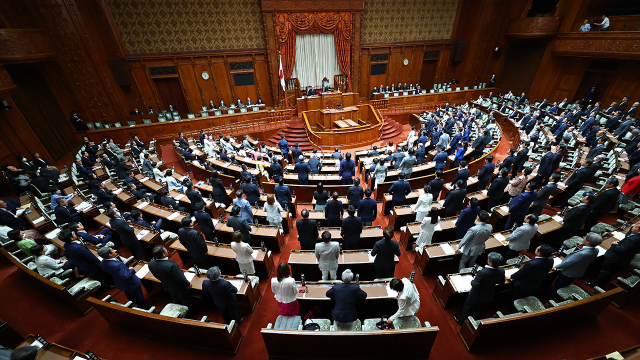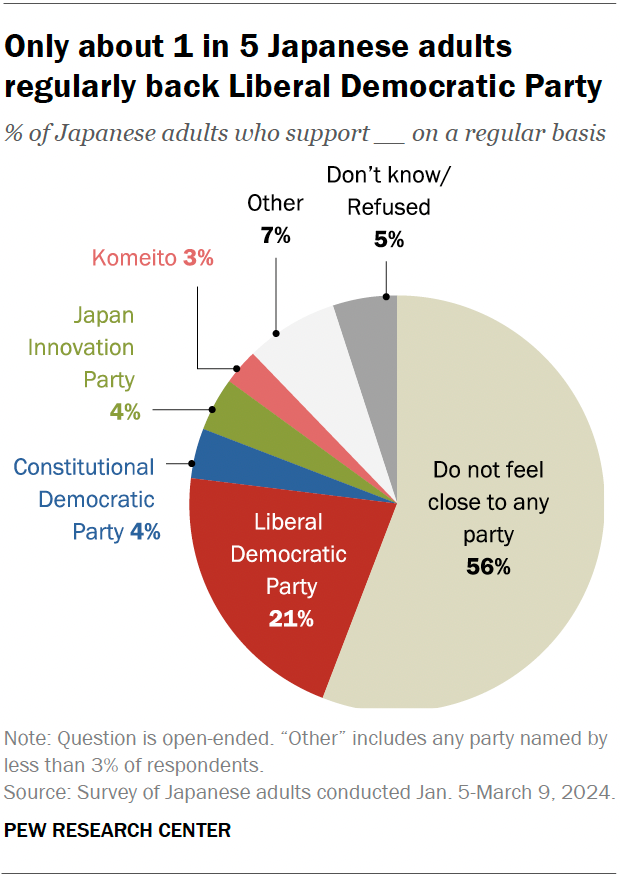
Japan’s new prime minister, Shigeru Ishiba, has called a snap election for Oct. 27, saying he wants his administration to face a public vote of confidence “as soon as possible.” Ishiba’s Liberal Democratic Party (LDP) has led Japan for nearly 70 consecutive years, but has been rocked by a slew of recent scandals.
Here are key facts about Japan’s democracy ahead of the election, based on a Pew Research Center survey of 1,003 Japanese adults, conducted Jan. 5-March 9, 2024. The survey was fielded amid a slush fund scandal that resulted in the indictment of several LDP lawmakers.
This Pew Research Center analysis highlights key findings about Japan’s ruling Liberal Democratic Party (LDP) and public attitudes about the country’s democracy ahead of a snap election on Oct. 27. This analysis draws on a nationally representative survey of 1,003 Japanese adults conducted from Jan. 5 to March 9, 2024. The survey was conducted over the phone.
Prior to 2024, combined totals were based on rounded topline figures. For all reports beginning in 2024, totals are based on unrounded topline figures, so combined totals might be different than in previous years. Refer to the 2024 topline to find how our new rounding procedures applied to past years’ data.
Here are the questions used for the analysis, along with responses, and the survey methodology.
Japan is unique among highly developed democracies for having had only one governing party for most of the last seven decades. The Liberal Democratic Party has held power in Japan for 65 of the 69 years since the party’s founding in 1955. In all other member states of the Organization for Economic Cooperation and Development (OECD) – a group of mostly highly developed, democratic countries – no party has held power for as much of the last seven decades.
Even some of the other relatively long-serving parties in OECD countries, such as the Christian Democratic Union in Germany and the Conservative Party in the United Kingdom, have ruled their countries for fewer than five decades over this same time period.
While the LDP has remained in power for decades, it often rules in coalition with other parties. For example, it has relied heavily on its coalition with the Buddhist Komeito party since 1999.

Favorability of Japan’s Liberal Democratic Party has declined significantly since 2023. As of this past March, only 30% of Japanese adults had a favorable view of the LDP, while 68% had an unfavorable view. This represents a sharp decline from 2023 and marks the lowest favorability rating for the party in our seven years of polling on the topic.
Other political parties in Japan are similarly unpopular today. For example, only 29% of Japanese adults have a favorable view of the LDP’s main opposition party, the Constitutional Democratic Party (CDP).
Still, views of the CDP have consistently been fairly negative, while the decline in views of the LDP over the past year has been much more pronounced.
Most Japanese adults (56%) say they do not feel close to any political party. This is far higher than the share of adults who do not identify with any political party in other countries surveyed, as the Center has reported previously.

In Japan, a large majority of people who do not feel close to any party also do not lean toward one particular party over others.
Indeed, only 21% of Japanese adults say they support the LDP on a regular basis. Still, this is far more support than any other party receives. The next closest are the opposition Constitutional Democratic Party and Japan Innovation Party, at 4% each.
Low party enthusiasm may also relate to low turnout. Previous analysis by Pew Research Center shows that Japan is among the OECD countries with the lowest voter turnout, despite having automatic voter registration.

Only around a third of Japanese adults say they are satisfied with the way democracy is working in their country today. This marks the lowest point in a steady downward trend since 2019.
Still, those with a favorable opinion of the governing Liberal Democratic Party are much more satisfied with democracy than those who have an unfavorable view of the LDP (58% vs. 19%). This has consistently been the case in recent years.
Note: Here are the questions used for the analysis, along with responses, and the survey methodology.
